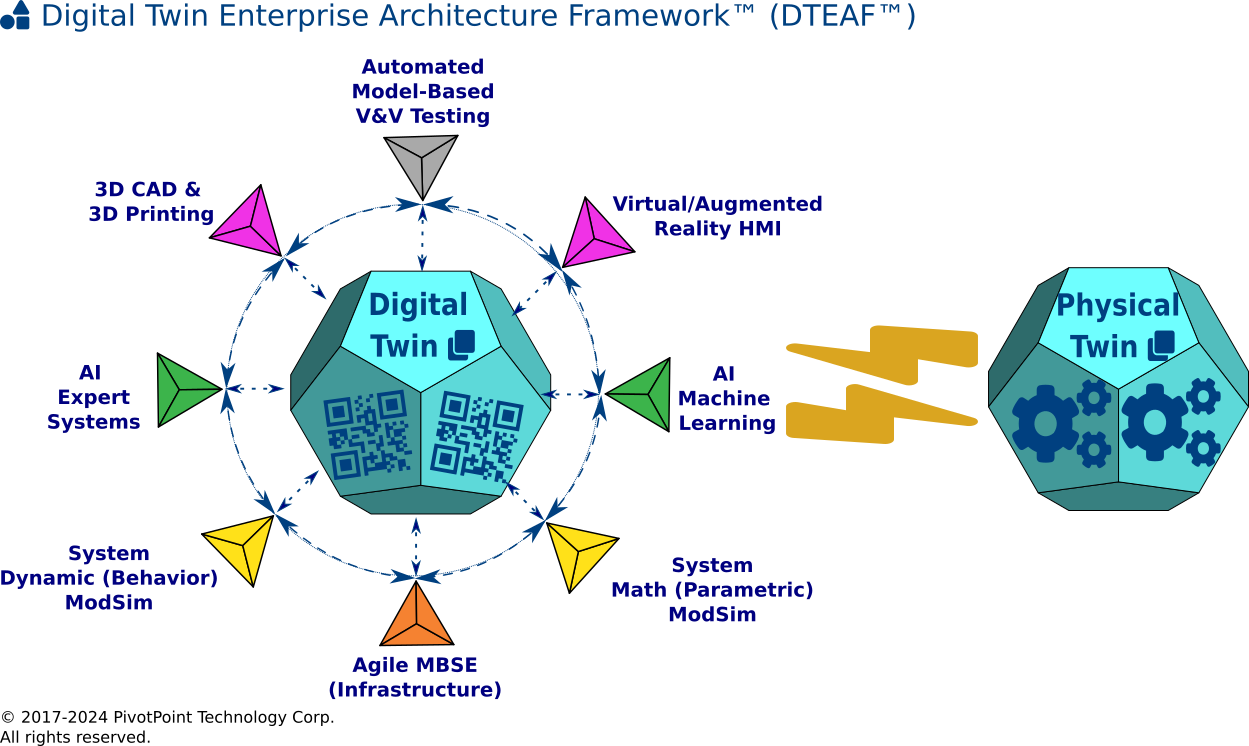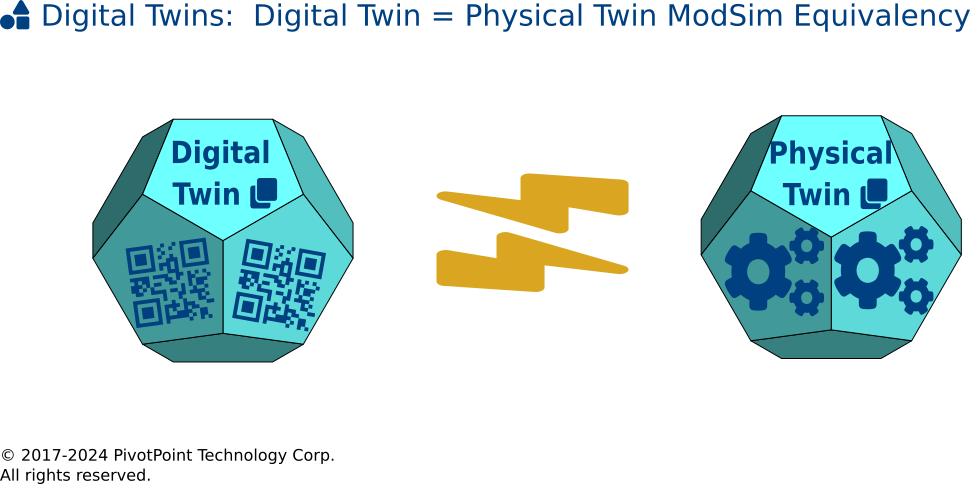PivotPoint FAQ: What is relation betw/ ModSim & Digital Twins?
What is the relation between ModSim & Digital Twins?
FAQ Variant(s): Why Do Large-Scale ModSim Initiatives Typically Miss the Mark on Digital Twins?
Although the DoD Modeling and Simulation Management Directive (DoDI 5000.2-R) published in 2007 advocated for "Planning for Simulation-Based Acquisition (SBA) and Modeling and Simulation (M&S) ... throughout the product life cycle", the promises of applying ModSim (the more mnemonic acronym for "Modeling & Simulation") for large-scale, complex software-intensive "systems-of-systems" (SoS) engineering have not yet been realized. Although ModSim continues to be closely associated DoD's 2018 DOD Digital Engineering Strategy report, which laid the groundwork for the more recent DoD Instruction 5000.97 for Digital Engineering, the role of ModSim in achieving the elusive visionary goals of Digital Threads and Digital Twins is vague and ambiguous.
Insightful engineers and project managers universally acknowledge the critical role of Modeling and Simulation (ModSim) in fulfilling the goals of Digital Threads and Digital Twins. Yet, deploying ModSim in software-intensive systems-of-systems (SW-intensive SoS, or simply SoS) often falls short of expectations. This is largely due to the prevalence of ModSim practices in SoS architectures at CMMI Maturity Level 1, marked by ad hoc, chaotic processes and architectures that are both low-fidelity (lacking precision and clarity) and high-entropy (prone to disorder, in alignment with the Second Law of Thermodynamics). Implementing an ad hoc ModSim approach on such a low-fidelity, high-entropy SoS architecture invariably leads to what can metaphorically be termed a "Bad" or "Evil" Digital Twin. On the flip side, employing a detailed and methodical ModSim approach on a high-fidelity, low-entropy SoS architecture predictably yields an Executable SoS architecture, essentially a "Good" Digital Twin, virtually indistinguishable from its Physical Twin counterpart.
How do we successfully create Executable SoS Architectures or effective Digital Twins? The key lies in developing high-fidelity, low-entropy SoS architectures capable of seamlessly scaling and incorporating dynamic (behavioral) and mathematical (parametric) ModSim elements from coarse to fine granularity. An expert System Architect views all SoS Architectures as composed of a matrix of horizontal and vertical "slices" - the horizontal slices being known as architectural "layers" or "views", and the vertical slices termed "partitions" or "requirements traces". This architecture matrix, when skillfully interwoven with fine-grained vertical traces and coarse-grained horizontal views, lays the groundwork for Executable SoS Architectures, akin to how the careful weaving of warp (strong vertical thread) and weft (or woof; softer horizontal thread) in tapestry weaving forms a base for intricate images or patterns (motifs). This analogy extends to how SoS architecture matrices can be progressively refined with ModSim patterns to eventually produce high-fidelity Digital Twins indistinguishable from Physical Twins (real systems):
Executable SoS Architecture => Digital Twin :
Vertical Traces + Horizontal Views + ModSim Patterns
:: [is analogous to]
Tapestry Weaving w/ intricate patterns (motifs):
Warp (strong vertical threads) + Weft (weaker horizontal threads) + [Weft-Manipulated] Patterns
Reflecting on the past two decades of DoD and commercial SW-intensive SoS projects, it's evident that those employing a non-Architecture-centric (i.e., ad hoc) approach to ModSim frequently attain mediocre or subpar results. In contrast, a smaller fraction of projects that embrace an Architecture-centric methodology to ModSim, despite requiring more initial investment in Architecture & Design, tend to achieve higher quality and greater efficiencies, saving both time and money.
Presently, there are two primary methodologies observed in the development of Digital Twins using ModSim and MBSE tools:
Ad hoc, High-Fidelity, High Entropy Digital Twin ModSim Techniques: These methods prioritize ModSim capabilities over the development of Executable SoS Architectures, known for their visually impressive simulations but often fall short in maintaining cohesion and integrity within the SoS architecture. This shortfall typically results in less effective Digital Twins. Common tools for these techniques include comprehensive ModSim suites like MATLAB + Simulink + SimScape, or specialized "stitchware" such as Ansys and STK.
Architecture-Centric, High-Fidelity, Low Entropy Digital Twin ModSim Strategies: In contrast, these strategies focus on developing a scalable and robust Architecture-centric MBSE + SysML System-of-System framework, exemplified by the Agile MBSE 6D Enterprise Architecture Framework™ (Agile MBSE 6D EAF™). This foundation supports the gradual integration of high-fidelity dynamic behavioral and mathematical (parametric) ModSim elements into the architecture's structure. Although initiating this process might take longer, by reducing the entropy within the SoS architecture rather than increasing it, this approach is far more effective in achieving what can be considered a "Good" Digital Twin, echoing the moral of the "Tortoise and the Hare" fable.
For further insights into PivotPoint's straightforward, Architecture-Centric MBSE + SysML + ModSim methodology for crafting Digital Twins, please reach out for more information or to request a demonstration.
UML, BPMN, OMG SYSML, and UPDM are trademarks of the Object Management Group.
ENTERPRISE ARCHITECT is a trademark of Sparx Systems Pty Ltd. MAGICDRAW and CAMEO are trademarks of No Magic, Inc. RATIONAL RHAPSODY is a trademark of IBM.
All other trademarks are the property of their respective owners.

